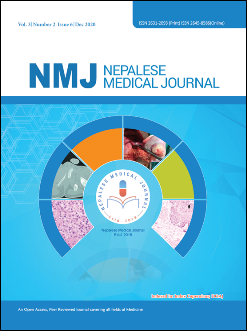Clinical assessment of impacted lower third molars at Ekpan, Delta State in Nigeria
DOI:
https://doi.org/10.3126/nmj.v3i2.29486Keywords:
Impacted; Lower; Third; Molars; NigeriaAbstract
Introduction: Diagnosis and management of impacted mandibular third molars call for a cogent appraisal and treatment choice both for the sick person and the dental practitioner. This academic work scrutinized the pattern as well as treatment of impacted mandibular third molars at the Teem Clinic and Dental Centre, Ekpan, Delta State, in Nigeria.
Materials and Methods: This cross-sectional survey involved 131 cases who reported impacted mandibular third molars. The age, gender, impacted tooth, type of impaction, pathological conditions, and treatment proffered were recorded.
Results: The male to female ratio was 0.8:1, with an age range of 10 to 40 years. Of the lower third molar impactions 58 (42.0%) were mesioangular, 5 (3.6%) horizontal, 18 (13.0%) vertical and 57 (41.3%) were distoangular. A total of 47 (34.1%) quested for dental attention following varying degrees of pain induced by pericoronitis. Teeth removal was accomplished for 76 (55.0%) owing to carious lesions on the impacted teeth, proximate tooth, or both. Surgical extraction was the option taken in 69 (50.0 %) with caries on the impacted teeth while 3 (2.2%) had to pull out of their teeth done owing to carious lesions on the bordering second molars. In 3 (2.2%) both the impacted third molar and the proximate second molar were decayed.
Conclusions: The prevailing indication for pulling out impacted mandibular third molars was acute pericoronitis. Mesioangular sort of impaction was most recurrent and ought to be considered for the
plausibility of frequentness of complications.
Downloads
Downloads
Published
How to Cite
Issue
Section
License
This license enables reusers to distribute, remix, adapt, and build upon the material in any medium or format, so long as attribution is given to the creator. The license allows for commercial use.
Copyright on any article published by Nepalese Medical Journal is retained by the author(s).
Authors grant Nepalese Medical Journal a license to publish the article and identify itself as the original publisher.
Authors also grant any third party the right to use the article freely as long as its integrity is maintained and its original authors, citation details and publisher are identified.




